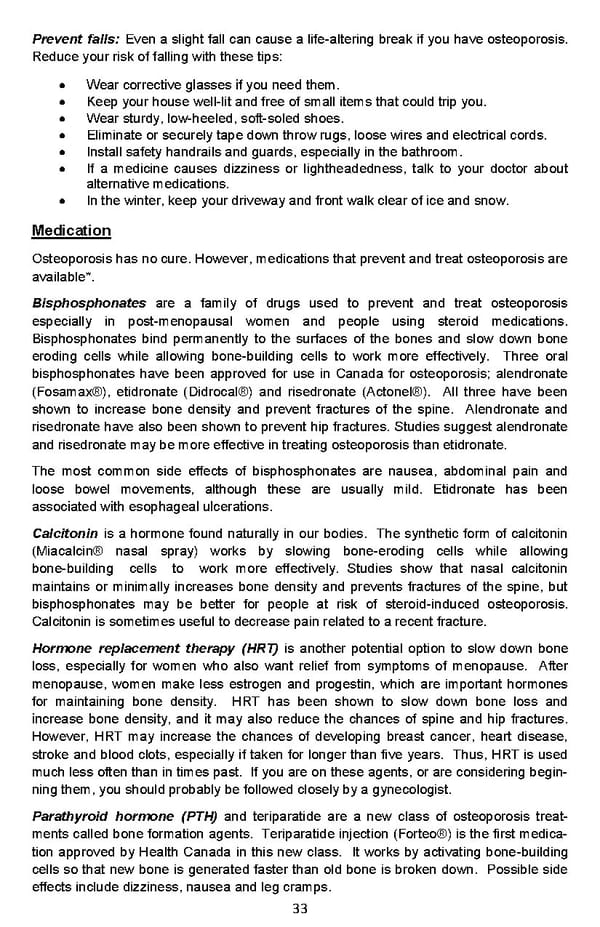Prevent falls: Even a slight fall can cause a life-altering break if you have osteoporosis. Reduce your risk of falling with these tips: • Wear corrective glasses if you need them. • Keep your house well-lit and free of small items that could trip you. • Wear sturdy, low-heeled, soft-soled shoes. • Eliminate or securely tape down throw rugs, loose wires and electrical cords. • Install safety handrails and guards, especially in the bathroom. • If a medicine causes dizziness or lightheadedness, talk to your doctor about alternative medications. • In the winter, keep your driveway and front walk clear of ice and snow. Medication Osteoporosis has no cure. However, medications that prevent and treat osteoporosis are available*. Bisphosphonates are a family of drugs used to prevent and treat osteoporosis especially in post-menopausal women and people using steroid medications. Bisphosphonates bind permanently to the surfaces of the bones and slow down bone eroding cells while allowing bone-building cells to work more effectively. Three oral bisphosphonates have been approved for use in Canada for osteoporosis; alendronate (Fosamax®), etidronate (Didrocal®) and risedronate (Actonel®). All three have been shown to increase bone density and prevent fractures of the spine. Alendronate and risedronate have also been shown to prevent hip fractures. Studies suggest alendronate and risedronate may be more effective in treating osteoporosis than etidronate. The most common side effects of bisphosphonates are nausea, abdominal pain and loose bowel movements, although these are usually mild. Etidronate has been associated with esophageal ulcerations. Calcitonin is a hormone found naturally in our bodies. The synthetic form of calcitonin (Miacalcin® nasal spray) works by slowing bone-eroding cells while allowing bone-building cells to work more effectively. Studies show that nasal calcitonin maintains or minimally increases bone density and prevents fractures of the spine, but bisphosphonates may be better for people at risk of steroid-induced osteoporosis. Calcitonin is sometimes useful to decrease pain related to a recent fracture. Hormone replacement therapy (HRT) is another potential option to slow down bone loss, especially for women who also want relief from symptoms of menopause. After menopause, women make less estrogen and progestin, which are important hormones for maintaining bone density. HRT has been shown to slow down bone loss and increase bone density, and it may also reduce the chances of spine and hip fractures. However, HRT may increase the chances of developing breast cancer, heart disease, stroke and blood clots, especially if taken for longer than five years. Thus, HRT is used much less often than in times past. If you are on these agents, or are considering begin- ning them, you should probably be followed closely by a gynecologist. Parathyroid hormone (PTH) and teriparatide are a new class of osteoporosis treat- ments called bone formation agents. Teriparatide injection (Forteo®) is the first medica- tion approved by Health Canada in this new class. It works by activating bone-building cells so that new bone is generated faster than old bone is broken down. Possible side effects include dizziness, nausea and leg cramps. 33
 Living Well With Lupus Facts Booklet Page 32 Page 34
Living Well With Lupus Facts Booklet Page 32 Page 34